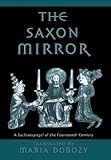The Saxon Mirror : A "Sachsenspiegel" of the Fourteenth Century / Maria Dobozy.
Material type: TextSeries: The Middle Ages SeriesPublisher: Philadelphia : University of Pennsylvania Press, [2014]Copyright date: ©1999Description: 1 online resource (272 p.) : 7 illusContent type:
TextSeries: The Middle Ages SeriesPublisher: Philadelphia : University of Pennsylvania Press, [2014]Copyright date: ©1999Description: 1 online resource (272 p.) : 7 illusContent type: - 9780812291285
- 340.5/5/094321 21
- KK205.6 .S231 1999eb
- online - DeGruyter
| Item type | Current library | Call number | URL | Status | Notes | Barcode | |
|---|---|---|---|---|---|---|---|
 eBook
eBook
|
Biblioteca "Angelicum" Pont. Univ. S.Tommaso d'Aquino Nuvola online | online - DeGruyter (Browse shelf(Opens below)) | Online access | Not for loan (Accesso limitato) | Accesso per gli utenti autorizzati / Access for authorized users | (dgr)9780812291285 |
Frontmatter -- Contents -- Translator’s Preface -- Abbreviations -- Introduction -- Imperial Landpeace of Main -- The Saxon Mirror Table of Contents -- Glossary -- Notes -- Bibliography -- Index
restricted access online access with authorization star
http://purl.org/coar/access_right/c_16ec
The Sachsenspiegel, or Saxon Mirror, compiled in 1235 by Eike von Repgow, may be said to mark the beginning of vernacular German jurisprudence. For the first time, Maria Dobozy offers an English translation of this influential lawbook, the oldest, and most important, set of customary law in the German language.This lawbook with its amendments marks a major shift in the history of German law from purely oral authority and transmission to a written documentation that allowed greater consistency in legal procedure. The reception of the lawbook was vast. It was rapidly adapted across Germany, as the four hundred manuscript versions demonstrate. Beyond Germany, it was copied as the paradigm for lawbooks in Prussia, Silesia, Poland, Ukraine, Hungary, and Bohemia. These codes of law became the standard for over three hundred years. The Sachsenspiegel contains a compilation of the legal practices at the time in Saxony, an ethnically mixed territory, and encompasses the legal customs and procedures that regulated the daily life of peasants and landlords. It is a multidimensional resource for anyone seeking insight into German and Central European culture in art, literature, linguistics, literacy, law, ethnic diversity, women, and the Bible.
Mode of access: Internet via World Wide Web.
In English.
Description based on online resource; title from PDF title page (publisher's Web site, viewed 23. Jun 2020)


